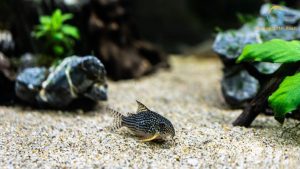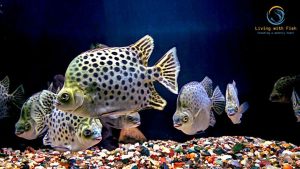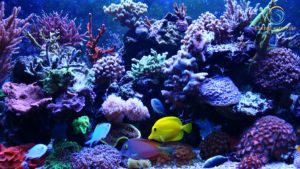This article covers the following areas –
- Why Do We Need Algae Eaters?
- Top Algae Eaters I’ve Fallen in Love With
- Some Tips for Introducing Algae Eaters
- Wrapping Up

Hey there, fellow fish enthusiast! If you’re anything like me, you’ve probably found yourself battling the green monster that is algae. I remember looking at my tank one day realizing that instead of enjoying the view of my lively fish, I was getting a front-row seat to an algae takeover. But fret not; I’ve been there, done that, and have discovered some pretty amazing algae eaters that can keep your tank crystal clear.
Top algae eater choices include Otocinclus Catfish, Siamese Algae Eaters, Amano Shrimp, and Nerite Snails for a pristine aquarium. These species effectively combat excessive algae, promoting a clean and balanced aquatic environment.
To truly grasp these algae eaters’ efficiency and unique behaviors, delve deeper into our comprehensive article. Understand their habitats, dietary preferences, and optimal tank conditions, ensuring you make an informed decision for your aquarium.
Why Do We Need Algae Eaters?
Ah, the ever-present algae. If you’ve ever had an aquarium, you know exactly what I’m talking about. Those green patches seem to sprout overnight, slowly taking over the pristine beauty of your tank. At first glance, you might wonder if this green intruder is an unwelcome guest or a natural part of aquatic life. Well, it’s a bit of both. Let’s dive into the intriguing world of algae and discover why nature gave us the gift of algae eaters.
The Good and the Bad of Algae
Algae and I have a love-hate relationship. Sometimes, the gentle green touch brings life to my tank, and at other times, it’s the unruly squatter I wish would take a hint. As I’ve learned over time, algae, like all things in nature, have their good and bad days. Let’s delve a bit deeper into this green conundrum.
The Bright Side of Algae
Many aquarists view it as a green menace, but there’s more to this aquatic plant than meets the eye. Just as roses have thorns yet are celebrated for their beauty, algae come with a bouquet of unexpected benefits. Let’s dive into the often-overlooked positives of this natural aquarium resident.
Food Source:
Watching some of my tank inhabitants graze on algae is fascinating, like cows in an underwater meadow. Tiny critters such as snails, shrimp, and even some fish varieties find algae a delicacy. It’s packed with nutrients and can be a beneficial supplement to their regular diet.
Natural Look:
Something is captivating about a tank that mirrors the wild, and a sprinkle of algae adds to that raw beauty. It creates a sense of authenticity reminiscent of freshwater streams and ponds.
Oxygen Producer:
Ever seen plants bask in the sun, glowing with life? Algae, though not as glamorous, have their moments too. Through photosynthesis, they use sunlight to produce energy, releasing oxygen as a by-product. This added oxygen can be a boon for your underwater buddies during the daylight hours.
The Dark Side of Algae
However, every coin has two sides, and while algae can play a beneficial role, it’s not without its downsides. There’s a balance to be struck, and an overzealous growth of algae can tip your tank’s ecosystem into chaos. Brace yourself as we navigate the shadowy waters of algae’s less desirable traits.
Light Blocker:
While a sprinkle of algae looks great, a blanket isn’t as charming. Overgrown algae can drape over aquatic plants like an oppressive curtain, blocking sunlight and inhibiting photosynthesis. Your aquatic plants need this light to thrive; without it, they can weaken and die.
Oxygen Hog:
Algae might be the gift that keeps on giving during the day, but come nightfall, the tables turn. Instead of producing oxygen, they consume it. If there’s too much algae, this nocturnal consumption can deplete oxygen levels, leaving your fish gasping and stressed.
Unsightly Blooms:
While a natural look is great, there’s a thin line between ‘natural’ and ‘neglected.’ Thick algae blooms can transform your tank from a crystal-clear haven to a murky swamp. It can stick to the walls, cloud the water, and cling to decor, making the beautiful landscape you’ve worked on a distant memory.
In the grand scheme, algae aren’t villains; they’re just overenthusiastic party guests. They come in to brighten things up but can overstay their welcome. Knowing the pros and cons helps us strike that delicate balance, ensuring our tanks remain healthy and stunning!
The Need for Nature’s Cleanup Crew
So, we’ve established that a bit of algae can be alright, even beneficial. But how do we keep it in check? Scrubbing it manually is an option, but who has time for that every other day? Plus, Mother Nature, in her wisdom, has given us a far more efficient and, frankly, exciting solution – algae eaters.
These critters are like the housekeepers of the aquatic world. They munch on algae, keep it under control, and, in doing so, help maintain the delicate balance of our tanks.
In a way, introducing algae eaters is like hiring a cleaning service for your tank. They keep the green menace at bay, ensuring the tank remains a healthy and beautiful environment for all its inhabitants.
Top Algae Eaters I’ve Fallen in Love With

If you’re anything like me, then you not only want your aquarium to be clean but also lively and interesting. Who wants just a clean, sterile-looking tank when you can have one filled with fascinating critters, each playing its part in the ecosystem?
Over my years of fish-keeping, I’ve discovered a few algae-eating stars that do a stellar job at keeping things clean and bring a dash of charisma to the tank. Let me introduce you to some of my favorite aquatic custodians.
1. Otocinclus Catfish (Oto)
The first time I laid eyes on these darlings, I was smitten. Small, sleek, and diligent workers, they reminded me of tiny aquatic vacuum cleaners.
Why I Adore Otos:
- Algae Patrol: They tirelessly patrol the tank, cleaning up plant leaves without causing any harm to the plants themselves.
- Community Minded: They’re peaceful and get along with most fish, so there’s no need to play referee in your tank.
- Better Together: Otos are like us during a movie night; they enjoy the company. Watching them work together in groups is endearing, making any algae outbreak seem like a fun challenge.
2. Siamese Algae Eater
The Siamese Algae Eater is like the superhero of the algae-eating world. They’re one of the select few that take on the notorious Black Beard Algae and win.
What Makes Them Stand Out:
- Specialty Diet: They have a penchant for some tougher algae types other fish might snub.
- Active Lifestyle: Always on the move, they bring dynamism to your tank. It’s like having your very own aquatic gymnast!
- Growing Pains: They do grow, so they appreciate a spacious home. Think of it as giving them a bigger playground.
3. Amano Shrimp
Amano Shrimp takes the cake if there’s an equivalent of a multi-tasker in the aquatic world. They scavenge, they clean, and they entertain.
Why They’re My Favorites:
- Algae Appetite: Their love for green hair algae is unmatched. It’s like watching someone enjoy a gourmet meal.
- Stealth Mode: Their transparent bodies allow them to play hide and seek, offering you mini treasure hunts as you spot them.
- Safety First: Just a heads up – bigger fish might find them tempting, so choose their tank mates wisely!
4. Nerite Snails
Think of them as the slow and steady warriors against algae. Their pace might be leisurely, but their efficiency? Top-notch!
The Beauty of Nerite Snails:
- Designer Shells: They’re not just cleaners but also natural decor pieces with their intricate shell designs.
- Surface Cleaners: They’re excellent at getting to those hard-to-reach spots and thoroughly cleaning them.
- Peaceful Existence: They’re easygoing and don’t bother other tank inhabitants. Perfect for a harmonious tank vibe!
Whether you’re battling a sudden algae bloom or just looking to add some natural cleaners to your tank, these critters have got you covered. Each brings its own flair and function, making your tank cleaner and livelier. So, why not offer them a spot in your aquatic world and watch the magic unfold?
Some Tips for Introducing Algae Eaters
Do you know the feeling you get when you buy a new gadget and you’re super eager to use it without reading the manual? Yep, I’ve been there, but with algae eaters. In my excitement, I made a few slip-ups, which, in hindsight, could’ve been avoided with a bit of knowledge and patience.
While these creatures are little miracle workers for our tanks, introducing them correctly is crucial. Let’s dive into some of the essential dos and don’ts I’ve gathered.
The Art of Acclimatization
Imagine suddenly shifting from a comfy room to the chilling cold outdoors. Shocking, right? That’s how fish feel with a sudden change in water conditions.
Low and Steady:
- Bag Method: Float the sealed bag you got them in, in your tank for about 15 minutes. This equalizes the temperature.
- Drip Method: This is my personal favorite for shrimp and sensitive species. Using a piece of airline tubing, let tank water drip into the container holding your new pets. It’s slow but ensures they gradually get used to your tank’s pH and hardness.
Resisting the Urge to Overfeed
I felt like a doting parent the first time I got my algae eaters. I showered them with food, only to realize I was turning them into lazy bums!
Striking a Balance:
- Monitor Food Consumption: If food pellets or flakes remain uneaten after a few minutes, you’re probably giving too much.
- Natural Diet: Remember, their primary job is to eat algae. By overfeeding, we might tempt them to abandon their primary role.
Regular Tank Maintenance
While it’s tempting to believe that our tanks will be self-sustaining with algae eaters, it’s far from the truth.
Why Maintenance Matters:
- Water Quality: Regular water changes reduce nutrients that algae thrive on.
- Equipment Check: Ensure filters and lights are working optimally. Overly bright lights or malfunctioning filters can boost algae growth.
- Plant Health: Healthy plants compete with algae for nutrients, so ensure they’re thriving.
While algae eaters are an excellent addition to our tanks, they aren’t a magic solution for negligence. It’s a partnership; they do their bit, and we do ours. With the right balance, you’ll have a vibrant, clear tank that’s a joy to behold!
Wrapping Up
Maintaining a clean and clear aquarium is not merely an aesthetic endeavor but a pivotal step toward ensuring a healthy environment for its inhabitants. While algae play a natural and sometimes beneficial role in aquatic ecosystems, an overgrowth can disrupt the delicate balance we aim to achieve in our tanks.
Introducing the right algae eaters—like the efficient Otocinclus Catfish or the hardworking Amano Shrimp—can make this challenge much easier. But remember, while these diligent creatures aid in maintaining clarity, the responsibility for overall tank health lies with us.
Regular maintenance, informed choices, and a dash of nature’s helpers can ensure that our aquatic havens remain both beautiful and thriving.






